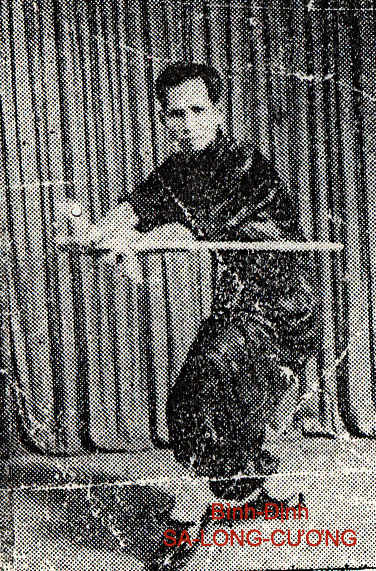II.
THE MEDIEVAL WEAPONS
2 - The Edged-Arms
THE SABRE
(ĐAO - 刀)
The Sabre Wielding
(Đao-Pháp -刀法)
The techniques of Sabre and Scimitar wielding teach the ways to use the « SIngle Sabre - Đơn-Đao » (單 刀) and the « Two Matched Sabres - Song Ðao » (双 刀).
All like that concerns the Sword, the Sabre Wielding from Đại-Việt inherent in the teaching of l'enseignement des méthodes d'utilisation of « Single Sabre Ðơn Ðao » (單 刀) and of « Two Matched Sabres Song Ðao » (双 刀) differs totally from Sabre Wielding of the China.
In « The Six Concordances of Sabre Wielding - Luc-Hợp Đao-Pháp » from China (had been teached by the Rector Master Trương Bá Đương in the Sa-Long Cương School Systel in Việt-Nam) the definition of Six fondamental Techniques of Sabre is as following :
«Triển » (展) = when we direct the Sabre Blade towards the exterior ;
« Mạt » (末) = when we direct the Sabre Blade towards the interior ;
« Câu » (勾) = when we hold the Sabre by folding the arm ;
« Đóa » (刴) = when we hold the Sabre in a horizontal position ;
«Khảm » (砍) = when we raise the Sabre above the head ;
« Phách » (劈) = when we hold the Sabre with two hands for striking from top to bottom.
That's precisely because of the fact to take the positions of the Sabre Blade in the space for defining these Six fondamental Techniques that the Sabre wielding - in this instance the techniques «Triển » (展) or « Đóa » (刴) - that the Sabre wielding from China differ totally from the one's of Đại-Việt. And we don't still tackle the techniques of left hand during the use of Single Sabre and the movement of postures during the use of Two Matched Sabres.
We need only to see a Master teaching a Martial Student one Codified Sequence of Single Sabre or Two Matched Sabres to be clear in our mind about the being part of this Master of a School from China or from Đại-Việt.
On the plan of Martial Arts Studies Culture, the discernement of differences between Martial Schools is truthly necessary.
The Single-Sabre Wielding
« Đao-Pháp Đơn Đao »
刀法單刀
Codified Sequence of Sabre Wielding
« The Dragon Killer »
(Đồ-Long Đao)
屠 龍 刀
The foundamental Codified Sequence of Sabre wielding from SA-LONG-CƯƠNG Martial Arts School System is the one's of Ðồ-Long-Ðao.
Truthly, there was an antique Codified Sequence of SIngle-Edged Sword including 31 coded lines of verse and whom the name have had forgotten.
Later, at tje time where the swashbuckling chinese novel, entitled « Ðồ-Long-Ðao » from writer Kim-Dung at Hong-Kong, became celebrious in South Việt-Nam during the years 1960-1962, the Grand-Maître Trương-Thanh-Đăng emprunta the title of this novel for giving a name to this antique Codified Sequence of Sword from Việt people still preserved.
This Codified Sequence of Sword was invented under LÝ Dynasty (1010-1225), at the time where the illustrious Generalissimo Lý-Thường-Kiệt (1019-1105) pacified the Champa and defeated the Song armies by besiegeing the two great southern provinces of China. Apart from the specifical techniques of Sword wielding, it still includes the six foundamental techniques : "Triển", "Mạt", "Câu", "Đóa", "Khảm", "Phách" from Sabre & Cimeterre wielding ; nevertheless, these ancient techniques must be correctely passed on to martial students so that they can assimilate in it the marvellous applications.
In the old days, Master Phi-Sơn-Hải wined the title of Fencing Champion at Hà-Nội in 1937 with the technique « Bạt-Thảo Tầm Xà » in the aforementioned Codified Sequence.

Master Phi-Sơn-Hải
(1937)
Under the political regime of Republic from President Ngô-Ðình-Diệm, this ancient Codified Sequence of Sabre had been suggested by Master Phi-Sơn-Hải - who teached at this period in his school located at the Yên-Đỗ Street - to the training of South Vietnam militaries, in view to fight "Battalions of Scimitar" from North Vietnam Army who began to rage on the war fronts in South Vietnam, while the South Vietnam Army didn't still own the modern assault gun M16 / AP15 but only Garant M1. However, the General Staff of Ngô-Ðình-Diệm had rejected this suggestion of Master Phi-Sơn-Hải.
The irony of fate wanted that this ancient Codified Sequence of Sabre, preserved in Sud-Vietnam, having been suggested to the training of militaries for fighting the Scimitar wielding from "Battalions armed with Scimitar - Mã-Tấu" of Nord-Vietnam Army, and refused and mistreated by the authorities of South Vietnam, had to wait for the days which followed the unification of Việt-Nam to be reminded by a North-Vietnamese Writer who disclosed its existence.
This ancient Codified Sequence of Sabre didn't it have been always linked to the spiritual soul of mountains and rivers of Việt-Nam ?
The Two-Matched Sabres Wielding
« Đao-Pháp Song Đao »
刀法双刀
Codified Sequence of Two-Matched Sabres
« Ten-Thousand Flowers Sabre »
(Vạn-Hoa Đao)
萬花刀
The famous Codified Sequence of Two Matched Sabres from Martial Arts Land of An-Vinh is well « Vạn Hoa Ðao - Ten-Thousand Flowers Sabre » including 7 coded verses with 44 characters, codifying 14 techniques in frequently unpredictable transformations, drew inspiration from Four Fabulous Animals (Dragon, Unicorn, Turtle and Phoenix).
There is a Codified Sequence inherent in Martial Arts of Battle Fields with Two-Matched Sabres techniques of continual linked attacks and defences appearing as much as ten of thousand edged steel petals wraping up the adversary.
This Codified Sequence of « Two-Matched Sabre Song Ðao » belongs to Martial Arts School System of the late Grand-Master Khiển-Thi (Commander Thi) and it is passed down to the following generation by his descendant, the Grand-Master Ba-Phong.
(To be continued...)
Committee of TRỊNH Quang Thắng |
Copyright © 2004 - 2016 by ACFDV - All rights reserved.
